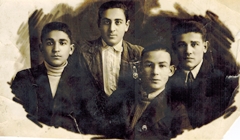
Michael (on the left) with classmates, 1940, Klimovichi
|
Operation Barbarossa, Nazi Germany’s military invasion of the Soviet Union, began on June 22, 1941. The German military swiftly advanced eastward into Russia and what are now the Baltic States, Belarus, and Ukraine.
There was an air of panic as refugees from conquered areas started coming into Klimovichi. The refugees told horror stories of Germans burning down entire villages and killing almost everybody. However, even this was not enough for the Lokshin family to leave behind their belongings and run.
The Lokshin family had built their house in a course of nine years, by saving every penny.
|
Their house even had a tin roof while most of the neighboring houses had cheap wooden roofs. The thought of leaving that house was intolerable.
By the end of July 1941, Klimovichi was not yet under attack. However, many residents had fled to escape while they still could. Some residents were drafted into the Soviet Red Army, some moved their families further east into the Soviet Union, and others went by train to work in factories at the outskirts of European Russia along the Volga River.
That month, Michael Lokshin’s family split up. With the Soviet Red Army drafting all men at age of 18, and Michael being just 17, he was too young to be conscripted but his father Zalman was drafted as a military cook. While in the Red Army,
Zalman heard stories of the vicious treatment of the Jews by the Germans, so he asked his family, including Michael, to leave Klimovichi as soon as possible.
Luckily for the people of Klimovichi, they had a train station. So when the German Army began its approach and the residents of Klimovichi had to flee, there was an escape out of the region that was quick and more effective than riding a wagon or horse.
Michael, his mother, his sister Sonya, and his younger brother David all left Klimovichi by train on July 15, 1941, to live in Kuybyshev with cousins they had never seen. They traveled with a few blankets, a hand-cranked Singer’s sewing machine, and the clothes on their backs.
They rode on an empty, no-roof, coal platform with about 20 other people who at different points along the way would get off the train as others hopped on as space became available. Along the way, the train stopped at the small town of Borisoglebsk.
Michael got off the train to look for some extra food and drinking water, and ran into a group of his old classmates who recently had been drafted into the Red Army (Michael at this time was still 17, but his slightly older classmates already were over the age of 18).
Michael’s friends were on their way to the front lines, westward. While Michael was talking to his former classmates, his train left the station without him. It took Michael two days to catch up with the train and his family. (After the war Michael discovered that every one of the friends he had met at that small train station had died in combat during the war.)
One month later, on August 10, 1941, the Germans entered Klimovichi. |
|